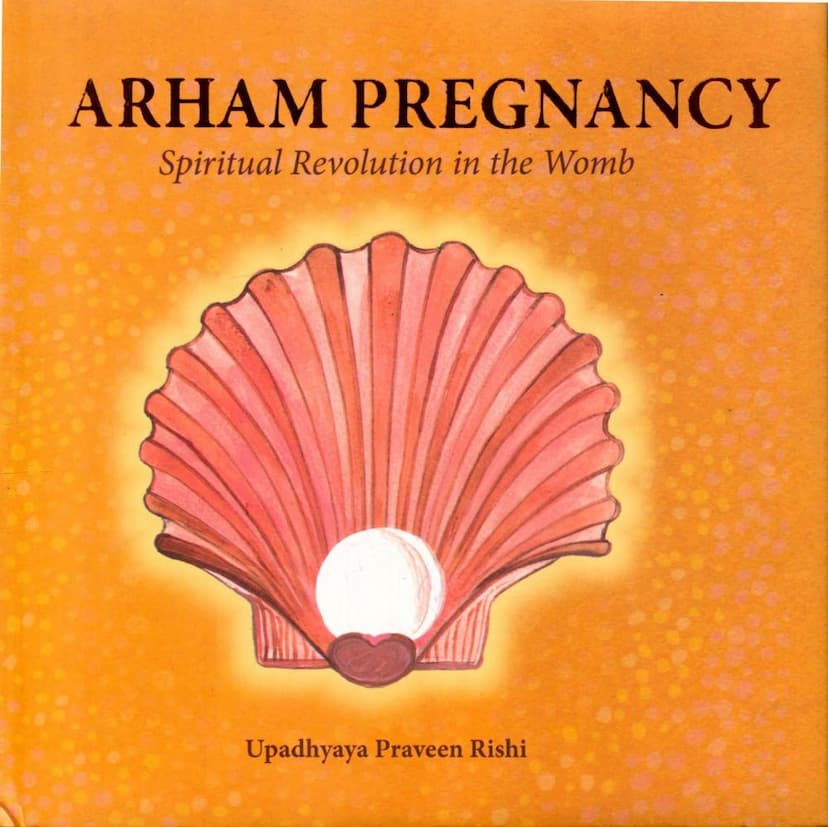Arham Pregnancy
Added to library: September 1, 2025

Summary
Here's a comprehensive summary of the Jain text "Arham Pregnancy" by Pravin Rishi Upadhyay and Pratibha Jain:
Overall Concept:
"Arham Pregnancy: Spiritual Revolution in the Womb" is a profound guide rooted in Jain scriptures, aiming to transform parenthood into a conscious, spiritual, and joyful experience. It emphasizes the active role of both parents, particularly the mother, in shaping the destiny, character, and well-being of their unborn child through specific spiritual practices (sadhana). The book draws inspiration from the lives of revered Jain figures, like Queen Trishla, mother of Lord Mahavira, who exemplified divine motherhood.
Key Principles and Practices:
-
Conscious Parenthood: The book stresses that childbearing should be a deliberate decision based on understanding parental responsibility and purpose, not societal pressure or obligation. Parents are encouraged to aim for "divine parenthood" and aspire to raise "epoch-heroes" – individuals who will positively impact the world.
-
The Power of Thought and Aura: A central theme is that the thoughts, emotions, and overall aura of the parents, especially the mother, directly influence the developing fetus. This influence shapes the child's character, disposition, and even their karmic trajectory.
-
The Importance of Relationships: Strong, harmonious marital relationships are considered the foundation for creating a spiritual family unit. The book advocates for mutual respect, fulfillment, and resolving conflicts, emphasizing that the quality of parental relationships directly impacts the child.
-
Leshya (Subtle Energetic Coloring): Jain philosophy's concept of Leshya, the subtle coloring of the soul based on mental and emotional states, is crucial. The book explains how parents can consciously cultivate positive Leshya (Shukla Leshya – white, auspicious) to influence the child's Leshya, transforming potential negativities into auspicious qualities.
-
Dream Meditation (Swapna Sadhana): The book highlights the significance of dreams as a communication channel between the fetus and the mother. It details the fourteen "great dreams" described in the Kalpa Sutra, seen by mothers of Tirthankaras, as indicators of the child's extraordinary potential. Meditating on these dreams is presented as a way to connect with divine energies and prepare for a special child.
-
Breath Connection (Swar Sadhana): The text emphasizes the role of breath in connecting the mother and child. It teaches the practice of observing and controlling breath (solar and lunar breaths) to create a stable and harmonious environment within the womb, essential for the fetus's well-being.
-
The Arrival and Welcome of the Being: The book stresses the importance of recognizing and consciously welcoming the soul's entry into the womb. This "welcome" involves emotional preparedness, purity, and communicating feelings of joy and love, establishing a strong initial bond.
-
Namothunam Sadhana: This is presented as a core spiritual practice of "Arham Pregnancy." It involves chanting a powerful mantra in praise of the Tirthankaras, aiming to imbue the child with their divine qualities, strength, and spiritual prowess. This sadhana is structured to be practiced across the three trimesters of pregnancy.
-
Holistic Lifestyle: The book outlines a comprehensive lifestyle approach for expectant parents, emphasizing:
- Dietary Purity: Consuming sattvik (pure, vegetarian), home-cooked meals, respecting seasonal availability, and mindfully preparing food.
- Emotional Stability: Avoiding negative emotions, stress, and tears; maintaining cheerfulness, and resolving conflicts.
- Sensory Purity: Avoiding loud music, stressful television programs, and embracing classical music and positive literature.
- Physical Well-being: Gentle exercise, especially pranayama, and abstaining from physical intimacy during pregnancy to protect the fetus.
- Cultural Values: Engaging in activities that promote spiritual and emotional growth, like listening to inspiring music and reading scriptures.
-
The Father's Role: While the mother is the primary focus for nurturing the fetus, the father's role is equally vital. He is encouraged to support his wife through sadhana (like Swastik-Srivatsa meditation), maintain a positive aura, and communicate love and good wishes, which also reach the child.
-
Postnatal Care: The principles of vigilance and conscious parenting extend beyond birth. This includes affectionate gazing, respecting the baby's natural body clock, naming the child with auspicious intent, avoiding forceful imposition of parental ambitions, and focusing on emotional development and sensitivity.
-
Sadhana for Extraordinariness: The entire program is geared towards enabling parents to foster extraordinary qualities in their children, drawing parallels to the lineage of Tirthankaras.
Underlying Philosophy:
The book is deeply rooted in Jainism's emphasis on karma, reincarnation, spiritual evolution, and the inherent potential within every soul. It provides practical methods derived from ancient wisdom to actively participate in the divine process of creation, aiming to produce well-rounded, spiritually oriented individuals who can contribute positively to the world. It advocates for a conscious, spiritual approach to life, starting from the very conception of a child.